Contents
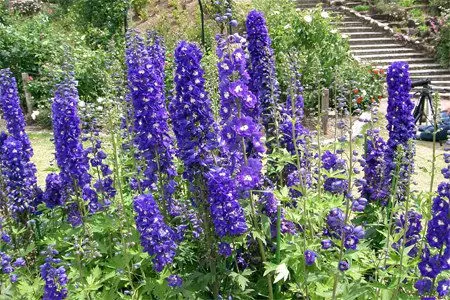
Larkspur or delphinium (lat. Delphínium) is not a single plant, but a numerous genus of annual and perennial herbs belonging to the Buttercup family. At least 400 species of delphinium are described in botany, distributed in North America, Eurasia and even some regions of Africa. In the vastness of Russia there are more than 100 species of larkspur, among which there are the main medicinal varieties (high larkspur, field larkspur, reticolobular larkspur).
In the medical literature, the terms “larkspur” or “spur” are used. The definition of “delphinium” is preferred by writers and gardeners who love a variety of larkspur hybrids for their excellent decorative qualities and unpretentiousness in cultivation.
Professionals separately consider the Sokirki genus (lat. Consolida), which includes about 40 annual delphinium varieties. Field juices are one of the definitions of field larkspur.
What does larkspur look like and where does it grow?
Larkspur does not grow more than 50-60 cm. The plant has a rather strong, massive root. The stem is erect, smooth, branching upwards. The shape of the leaves is palmate-branched with a serrated or sharp tip. During the flowering period from early summer to the first weeks of September, bright blue or purple flowers appear on the tops of the upper branches of the larkspur, which form an elongated inflorescence. The flower brush reaches a length of 25-35 cm.
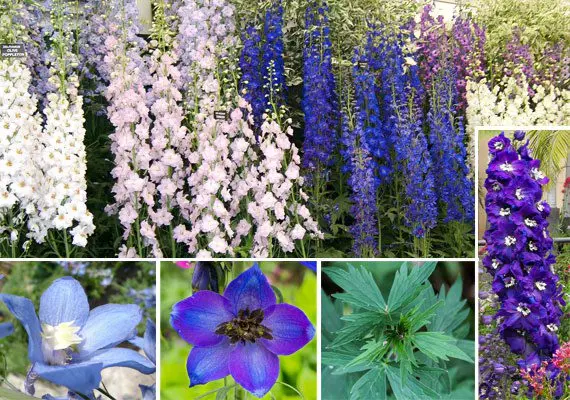
Types of larkspur
Larkspur field

Field larkspur (lat. Consolida regalis) – sometimes referred to in the specialized literature as field juices. An annual variety, the height of which can be from 20 to 70 cm. The straight stem branches upwards. In the structure of the sheet plate, straight segments are distinguished.
The flowering period falls on the summer months. On the top of the shoot, bright purple, blue, pink or white flowers appear, from which a lush brush is formed.
The field larkspur is harvested in Western Siberia and in the European part of Russia. The plant is often found in fields sown with winter crops, and therefore is perceived exclusively as a weed. The field larkspur is a poisonous plant, the herb and seeds of which can be included in the medicinal formulation. Owners of grazing animals make sure that there are no larkspurs in the grazing areas, which can lead to poisoning.
The green, herbaceous part of the plant has a diuretic effect. Flowers are included in the formulation of anti-inflammatory, expectorant compounds. In folk medicine, larkspur is used as a diuretic and antihelminthic. It has been established that field larkspur alkaloids have a curare-like effect.
The basis for the use of preparations based on larkspur is:
Headache and toothache.
Hypertension.
Cystitis.
Pleurisy.
Pneumonia.
Multiple sclerotic lesions.
Painful menses.
Local application of compounds of field larkspur is indicated for external bleeding. Ophthalmologists prescribe eye lotions for blepharitis, conjunctivitis.
Larkspur high
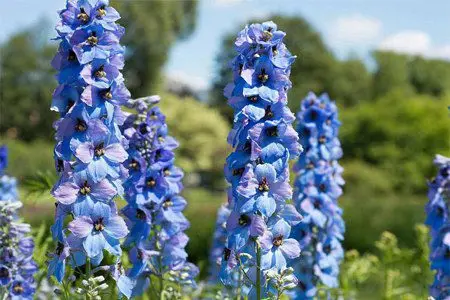
Perennial varieties include high larkspur (lat. Delphinium elatum) – a plant that grows up to two meters. The leaf plate consists of individual lobes that have serrated tops. The flowering period falls on the summer months. Rather large blue flowers (up to 2 cm) form long bright brushes. In the future, in place of the flowers, dark brown small trihedral seeds appear.
In nature, high larkspur is found in Siberia, some regions of Asia, North-Eastern Europe. Grass can be found in forests, in glades. Decorative varieties of delphinium come from high larkspur.
The herbaceous part and roots of high larkspur contain dangerous alkaloids, including diterpenes. Toxic components are absent in the flowers of the plant. The green parts of the high larkspur are used in folk medicine to make tea.
Reception of infusion provides a number of useful properties for humans:
Diuretic.
Improving blood quality.
Normalizing metabolic processes.
Antihelminthic.
Pain reliever
Mucolytic.
Anti-inflammatory.
Anticonvulsant.
Local irritant.
For safety reasons, treatment with high larkspur is carried out under the supervision of a physician to ensure a safe dosage.
The experience of traditional medicine shows that this type of plant is indicated for the treatment of:
Hypertension.
Migraine.
Conjunctivitis.
Cystitis.
Diseases of the respiratory system.
dropsy
Respiratory infections accompanied by high fever.
Burns.
Diseases of the digestive system.
Larkspur reticulum
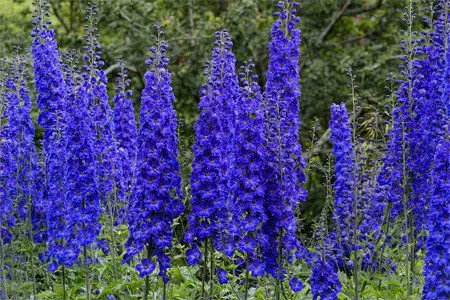
The reticulate larkspur (lat. Delphinium dictyocarpum), known as the bluish spur, is a perennial species. Plant height varies from 60 cm to 1 meter. The leaf blade is kidney-shaped, dissected into several lobes.
Delphinium blooms all summer. At this time, modified flowers appear on the plant, consisting of two nectaries, which form beautiful, dense inflorescences. The calyces of the flowers are dark blue, and the nectaries are white or blue. In August, seeds appear in place of flowers, which ripen by October.
Larkspur reticulum is found in meadows, grassy slopes. Growing regions – Kazakhstan, southern and Eastern European regions of Russia, expanses of Siberia, Altai Territory. For medical purposes, flowering tops of plants are collected. The best place for harvesting is Dzungarian Alatau.
In the green part and roots of the delphinium, alkaloids were found, among which there are muscle relaxants with a curare-like effect.
Preparations based on larkspur reticulum are prescribed for:
Multiple sclerosis.
Hypertonicity of the striated muscles.
Indigestion.
Oncological diseases.
Conjunctivitis, blepharitis.
Larkspur is the main component of the tablet drug “Melliktin”, which is prescribed for certain neurological diseases.
Larkspur pharmacy
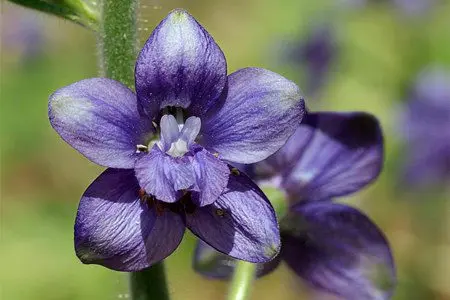
Pharmacy larkspur (lat. Delphinium officinal) is a biennial variety common in the Balkans and Turkey. Often the plant is grown as an ornamental, unaware of its beneficial properties.
The upright main stem has small branches. The leaves of the larkspur are divided into 5-6 fragments, shaped like a star. The flowers are purple, covered with tiny hairs, and form racemose inflorescences. The flowering period lasts from March to September.
Medicinal compositions based on larkspur have a positive effect on the physiological processes of the gastrointestinal tract, improve the condition of patients with inflammation of the meninges, foci of multiple sclerosis and Parkinson’s disease. The plant helps with indomitable cough, is used to treat bronchial asthma. The active substances of the larkspur relax the hypertonicity of the skeletal muscles, and are used to relieve signs of catalepsy. External use of phytopreparations with delphinium helps the healing of superficial wounds, ulcerative skin lesions.
Folk recipes with larkspur are traditionally used to treat:
Inflammation of the lungs.
Rheumatism.
Dysentery.
Headaches.
Hepatitis A.
Digestive disorders.
Edema, ascites.
Helminthiasis.
Compositions with pharmacy larkspur help tame vomiting, stop bleeding, and accelerate the recovery of broken bones. Adding herbal decoction to the bath helps with hyperactivity, nervousness in children.
Delphiniums
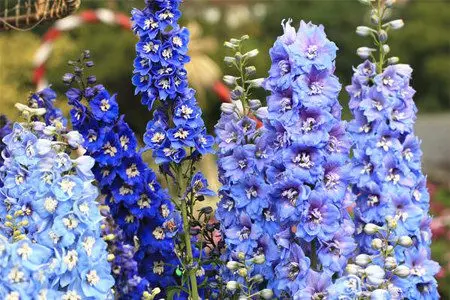
Delphiniums – a general definition of all decorative types of high larkspur. Thanks to the colorful inflorescences, plants are widely used in gardening and landscape design. Most varieties of cultural delphinium were obtained in the 19th century as a result of hybridization. All known varieties are highly poisonous.
None of the types of decorative delphinium is used for medical purposes.
The chemical composition of larkspur
Useful properties of larkspur are explained by its incredibly rich chemical composition. The green part of the plant contains:
Flavonoids.
Anthocyanins.
Kaempferol.
Tannins.
Ash compounds.
Alkaloids.
Trace elements – potassium, calcium, strontium, nickel, chromium, aluminum, selenium, barium, iron, molybdenum, magnesium, manganese, copper, zinc, cobalt.
[Video] Herbalist Antonenko E.Yu. – useful properties and use of high larkspur:
Contraindications to the use of larkspur
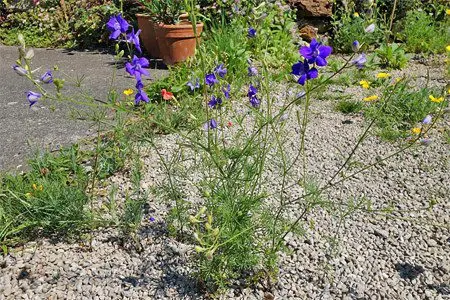
Absolute contraindications to taking compositions based on larkspur are:
Pregnancy.
Myopathy.
Myasthenia gravis.
Low blood pressure.
Renal failure.
Disorder of cardiac activity.
Any disease accompanied by low muscle tone.
With caution, larkspur preparations are prescribed to patients with bronchial asthma. Mandatory monitoring of the patient’s well-being in order to prevent apnea.
The use of delphinium for medicinal purposes requires caution – all parts of the plant contain poisonous alkaloids. If ingested, intoxication may develop, accompanied by breathing problems, convulsive muscle contraction, hypotonicity of the striated muscles.
Upon contact of the larkspur with the skin, the likelihood of local irritation is high. During the collection and processing of the plant, gloves, clothing covering the arms and legs should be worn.
First aid for larkspur poisoning
If the poisoning is caused by oral intake of larkspur, it is necessary to take activated charcoal, rinse the stomach with a 0,1% solution of potassium permanganate. Excessive curare-like effect is stopped by intravenous administration of 1 ml of a 0,1% solution of atropine and 1 ml of a 0,05% solution of prozerin.
In the case when the signs of intoxication are insignificant, it is advisable to double subcutaneous injection of 0,05% prozerin. With a sudden decrease in blood pressure, up to 1 ml of a 5% ephedrine solution is administered, as well as drip infusions of a cocktail of 0,2% norepinephrine hydrotartrate and 5% dextrose solution.
An attack of heart failure is stopped by subcutaneous injection of 1-2 ml of a 20% caffeine solution and 1-2 ml of a 20% camphor solution.
Recipes and ways to use larkspur
[Video] Ways to use larkspur root:









